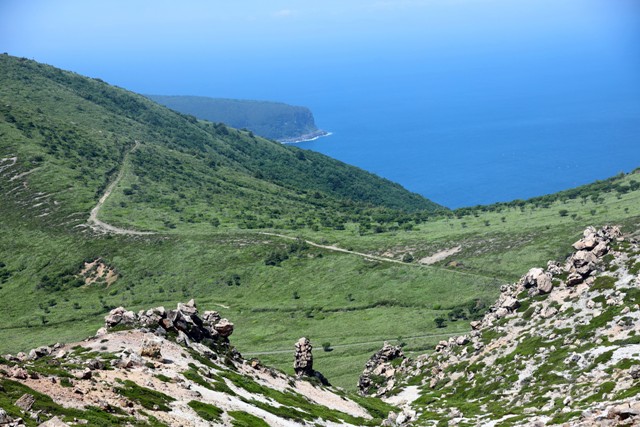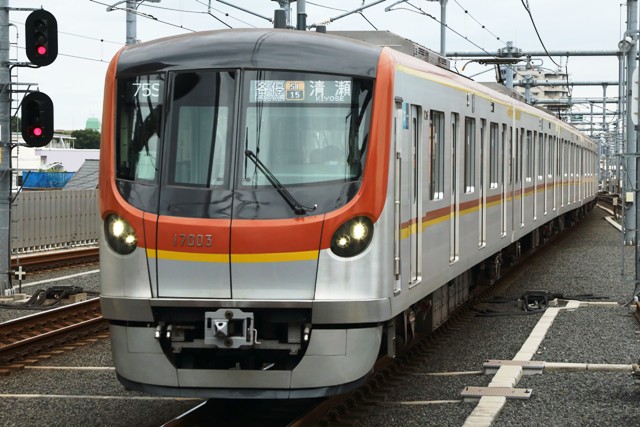 |
| Ex-Muroran station building |
Wednesday, 28 July 2021
Saturday, 24 July 2021
Access to the Recently Erupted Volcano
Usuzan Ropeway and Showa-shinzan
After visiting Mt. Hakodate, we headed north. Our next destination was a recently erupted volcano near Muroran City.
Showa-shinzan (new mountain of Showa-era) is a rhyolite volcanic lava dome with about 400 meters in height. It was abruptly created in an upland cropping area in 1944. Although it was in the middle of WWII, a local postmaster, Mimatsu Masao, surveyed the growing volcano in great detail. His research was very precious, and has been highly regarded among specialists.
For viewing the whole image of Showa-shinzan, Usuzan Ropeway is convenient. It's four cables - cross type aerial tramway. Connecting Showa-shinzan Sanroku (foot of Showa-shinzan) and Usuzan-sancho (summit of Mt. Usu) stations, its route length is 1,370 meters. Usuzan Sancho station is located 560 meters above sea level. The height difference between the two stations is 356 meters. Its maximum inclination is 24.17 degrees. The route was opened in 1965. The present gondolas, namely number 1 and 2, were built by CWA in Switzerland in 2020. Each gondola can accommodate up to 96 passengers including a conductor. The gondola is operated every 15 minutes with an operating speed of 5 meters per second. It takes about 6 minutes to go one way.
After arriving at the Usuzan-sancho station, we enjoyed a beautiful view of Showa-shinzan and adjacent Lake Toya. The brickish red-colored mountain face was very beautiful and impressive. It must be one of the best sceneries in the southern part of Hokkaido Island.
To be continued...
Tuesday, 20 July 2021
Superb View Spot in Hakodate City
 |
| Sancho station and a gondola (center left) of Mt. Hakodate Ropeway After returning from Mt. Esan, we planned to visit Mt. Hakodate near the downtown Hakodate area. A night view from Mt. Hakodate has been famous since the old days, and is one of the three best night views in the world together with Hongkong and Napoli. In other words, most tourists visit this spot in the evening, but it was still 3pm. What shall we do? We headed for Mt. Hakodate straightway as time was precious. To get to the summit of Mt. Hakodate, an aerial tramway is convenient, but we found that the operation starts at 5pm in the evening. We had to drive ourselves to reach the summit, which is located 334 meters above sea level. It took ten minutes or so from the foot of the mountain. The daytime view from the summit was indeed beautiful. It might be more fantastic than that of the night view. We were glad we could come here in the daytime. Incidentally, the aerial tramway, named Mt. Hakodate Ropeway, was opened in 1958. It's a three cables - cross type aerial tramway. Connecting Sanroku (Foot of the mountain) and Sancho (Summit) stations, its route length is 835.06 meters. The height difference between the two stations is 278.5 meters. Its maximum inclination is 28.97 degrees. Current gondolas are the fifth generation ones built by Osaka Sharyo in 2014. Each gondola can accommodate up to 125 passengers. The gondola is operated every 15 minutes. It takes about three minutes to go one way. To be continued,,, Official information about Hakodate Ropeway: https://334.co.jp/en/ |
Friday, 16 July 2021
Volcanic Scenery around Hakodate City
Monday, 12 July 2021
Early Summer Trip to Hokkaido Island
 |
| Interior of GranClass car, EMU JR East E5 series I recently retired from day-to-day management of my company. My busy and stressful days were finally over. I'm going to continue to work for the time being, but I will have more free time in the future, so, I will be able to answer your questions about Japanese railways. Thank you for your continued support to my blog. Although it was the COVID-19 calamity, I made a short trip to Hokkaido Island to spoil myself. On the first day, I took the Tohoku-Hokkaido Shinkansen (a high speed new trunk line) from Tokyo terminal. My vehicle was the EMU JR East E5 series. That was my first time to use GranClass (the first class) car on the Shinkansen. It's in Car 10 toward Shin-Hakodate-Hokuto station. GranClass is a bit expensive, but OK. That was my special retirement trip. I was able to relax during travelling from Tokyo to Shin-Hakodate-Hokuto station. Because of the COVID-19 calamity, passengers were only me and my family in the GlanClass car, while the train passed through the long Seikan Undersea Tunnel. What's the Seikan Undersea Tunnel? It lies between Honshu and Hokkaido islands with Its total length of 53.85 kilometers. It was completed in 1988, and had been the world's longest tunnel until 2010, when the Gotthard-Basis Tunnel penetrated through the Alps in Switzerland. Thanks to the subsea tunnel, it took only four hours from Tokyo to Shin-Hakodate Hokuto station by Super-express Hayabusa (Falcon) at a maximum speed of 320 kilometers per hour. To be continued... Official information about GranClass: https://www.jreast.co.jp/granclass/en/ |










